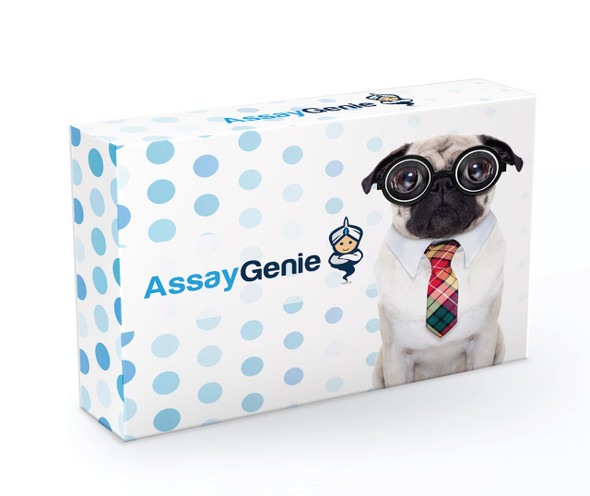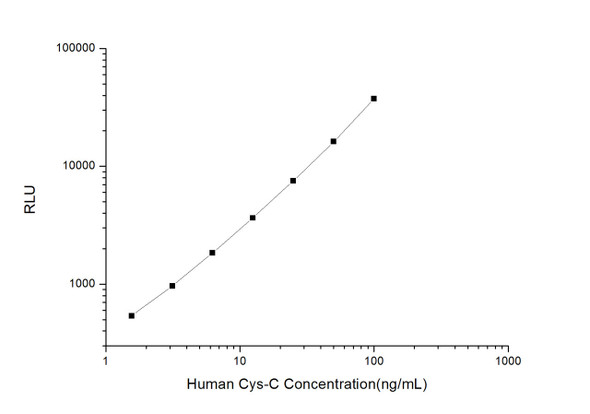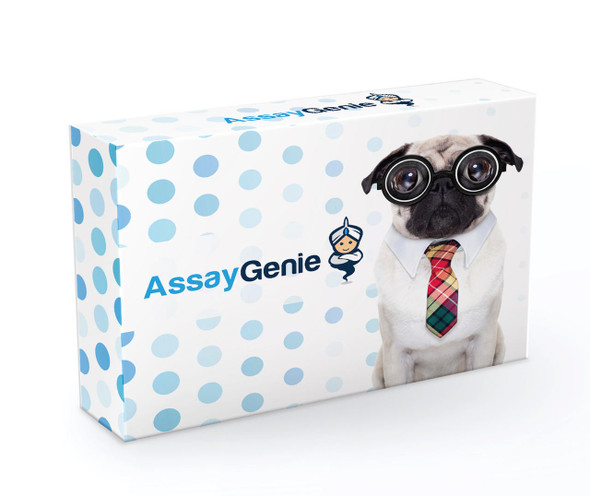Mouse Cell Signalling ELISA Kits 2
Mouse Cys-C (Cystatin C) CLIA Kit (MOES00216)
- SKU:
- MOES00216
- Product Type:
- ELISA Kit
- ELISA Type:
- CLIA Kit
- Size:
- 96 Assays
- Sensitivity:
- 18.75pg/mL
- Range:
- 31.25-2000pg/mL
- ELISA Type:
- Sandwich
- Synonyms:
- CST3, Cystatin 3, ARMD11, Post-Gamma-Globulin
- Reactivity:
- Mouse
- Sample Type:
- Serum, plasma and other biological fluids
Description
| Assay type: | Sandwich |
| Format: | 96T |
| Assay time: | 4.5h |
| Reactivity: | Mouse |
| Detection method: | Chemiluminescence |
| Detection range: | 31.25-2000 pg/mL |
| Sensitivity: | 18.75 pg/mL |
| Sample volume: | 100µL |
| Sample type: | Serum, plasma and other biological fluids |
| Repeatability: | CV < 15% |
| Specificity: | This kit recognizes Mouse Cys-C in samples. No significant cross-reactivity or interference between Mouse Cys-C and analogues was observed. |
This kit uses Sandwich-CLIA as the method. The micro CLIA plate provided in this kit has been pre-coated with an antibody specific to Mouse Cys-C. Standards or samples are added to the appropriate micro CLIA plate wells and combined with the specific antibody. Then a biotinylated detection antibody specific for Mouse Cys-C and Avidin-Horseradish Peroxidase (HRP) conjugate are added to each micro plate well successively and incubated. Free components are washed away. The substrate solution is added to each well. Only those wells that contain Mouse Cys-C, biotinylated detection antibody and Avidin-HRP conjugate will appear fluorescence. The Relative light unit (RLU) value is measured spectrophotometrically by the Chemiluminescence immunoassay analyzer. The RLU value is positively associated with the concentration of Mouse Cys-C. The concentration of Mouse Cys-C in the samples can be calculated by comparing the RLU of the samples to the standard curve.
| UniProt Protein Function: | CST3: As an inhibitor of cysteine proteinases, this protein is thought to serve an important physiological role as a local regulator of this enzyme activity. Defects in CST3 are the cause of amyloidosis type 6 (AMYL6); also known as hereditary cerebral hemorrhage with amyloidosis (HCHWA), cerebral amyloid angiopathy (CAA) or cerebroarterial amyloidosis Icelandic type. AMYL6 is a hereditary generalized amyloidosis due to cystatin C amyloid deposition. Cystatin C amyloid accumulates in the walls of arteries, arterioles, and sometimes capillaries and veins of the brain, and in various organs including lymphoid tissue, spleen, salivary glands, and seminal vesicles. Amyloid deposition in the cerebral vessels results in cerebral amyloid angiopathy, cerebral hemorrhage and premature stroke. Cystatin C levels in the cerebrospinal fluid are abnormally low. Genetic variations in CST3 are associated with age- related macular degeneration type 11 (ARMD11). ARMD is a multifactorial eye disease and the most common cause of irreversible vision loss in the developed world. In most patients, the disease is manifest as ophthalmoscopically visible yellowish accumulations of protein and lipid that lie beneath the retinal pigment epithelium and within an elastin-containing structure known as Bruch membrane. Belongs to the cystatin family. |
| UniProt Protein Details: | Protein type:Secreted, signal peptide; Secreted; Inhibitor Cellular Component: axon; basement membrane; cell projection; cell soma; contractile fiber; cytoplasm; endoplasmic reticulum; extracellular region; extracellular space; lysosome; multivesicular body; nuclear membrane; perinuclear region of cytoplasm; vesicle Molecular Function:beta-amyloid binding; cysteine protease inhibitor activity; endopeptidase inhibitor activity; identical protein binding; protease binding; protease inhibitor activity Biological Process: defense response; fibril organization and biogenesis; negative regulation of peptidase activity; negative regulation of proteolysis; positive regulation of cell proliferation; positive regulation of DNA replication; regulation of programmed cell death; response to oxidative stress |
| NCBI Summary: | The protein encoded by this gene is a cysteine protease inhibitor involved in neurodegenerative and cardiovascular processes. The encoded protein inhibits aggregation of beta-amyloid protein, a hallmark of Alzheimer's disease, so it may be useful as a therapeutic. This protein also may be a biomarker for atherosclerosis. [provided by RefSeq, Aug 2015] |
| UniProt Code: | P21460 |
| NCBI GenInfo Identifier: | 1345935 |
| NCBI Gene ID: | 13010 |
| NCBI Accession: | P21460. 2 |
| UniProt Secondary Accession: | P21460,Q544Y0, |
| UniProt Related Accession: | P21460 |
| Molecular Weight: | 15,531 Da |
| NCBI Full Name: | Cystatin-C |
| NCBI Synonym Full Names: | cystatin C |
| NCBI Official Symbol: | Cst3 |
| NCBI Official Synonym Symbols: | CysC |
| NCBI Protein Information: | cystatin-C |
| UniProt Protein Name: | Cystatin-C |
| UniProt Synonym Protein Names: | Cystatin-3 |
| Protein Family: | Cystatin |
| UniProt Gene Name: | Cst3 |
| UniProt Entry Name: | CYTC_MOUSE |
As the RLU values of the standard curve may vary according to the conditions of the actual assay performance (e. g. operator, pipetting technique, washing technique or temperature effects), the operator should establish a standard curve for each test. Typical standard curve and data is provided below for reference only.
| Concentration (pg/mL) | RLU | Average | Corrected |
| 2000 | 55696 55746 | 55721 | 55693 |
| 1000 | 22563 25385 | 23974 | 23946 |
| 500 | 11999 10065 | 11032 | 11004 |
| 250 | 4826 5762 | 5294 | 5266 |
| 125 | 2764 2452 | 2608 | 2580 |
| 62.5 | 1382 1240 | 1311 | 1283 |
| 31.25 | 665 683 | 674 | 646 |
| 0 | 27 29 | 28 | -- |
Precision
Intra-assay Precision (Precision within an assay): 3 samples with low, mid range and high level Mouse Cys-C were tested 20 times on one plate, respectively.
Inter-assay Precision (Precision between assays): 3 samples with low, mid range and high level Mouse Cys-C were tested on 3 different plates, 20 replicates in each plate.
| Intra-assay Precision | Inter-assay Precision | |||||
| Sample | 1 | 2 | 3 | 1 | 2 | 3 |
| n | 20 | 20 | 20 | 20 | 20 | 20 |
| Mean (pg/mL) | 102.35 | 281.96 | 916.38 | 99.43 | 301.18 | 981.29 |
| Standard deviation | 12.54 | 24.25 | 79.91 | 11.50 | 33.31 | 108.73 |
| C V (%) | 12.25 | 8.60 | 8.72 | 11.57 | 11.06 | 11.08 |
Recovery
The recovery of Mouse Cys-C spiked at three different levels in samples throughout the range of the assay was evaluated in various matrices.
| Sample Type | Range (%) | Average Recovery (%) |
| Serum (n=5) | 99-112 | 105 |
| EDTA plasma (n=5) | 87-101 | 93 |
| Cell culture media (n=5) | 93-109 | 101 |
Linearity
Samples were spiked with high concentrations of Mouse Cys-C and diluted with Reference Standard & Sample Diluent to produce samples with values within the range of the assay.
| Serum (n=5) | EDTA plasma (n=5) | Cell culture media (n=5) | ||
| 1:2 | Range (%) | 96-107 | 90-104 | 101-114 |
| Average (%) | 101 | 95 | 107 | |
| 1:4 | Range (%) | 87-101 | 102-117 | 99-109 |
| Average (%) | 94 | 110 | 104 | |
| 1:8 | Range (%) | 93-105 | 93-107 | 88-99 |
| Average (%) | 99 | 100 | 93 | |
| 1:16 | Range (%) | 91-106 | 99-113 | 90-103 |
| Average (%) | 97 | 106 | 96 |
An unopened kit can be stored at 4°C for 1 month. If the kit is not used within 1 month, store the items separately according to the following conditions once the kit is received.
| Item | Specifications | Storage |
| Micro CLIA Plate(Dismountable) | 8 wells ×12 strips | -20°C, 6 months |
| Reference Standard | 2 vials | |
| Concentrated Biotinylated Detection Ab (100×) | 1 vial, 120 µL | |
| Concentrated HRP Conjugate (100×) | 1 vial, 120 µL | -20°C(shading light), 6 months |
| Reference Standard & Sample Diluent | 1 vial, 20 mL | 4°C, 6 months |
| Biotinylated Detection Ab Diluent | 1 vial, 14 mL | |
| HRP Conjugate Diluent | 1 vial, 14 mL | |
| Concentrated Wash Buffer (25×) | 1 vial, 30 mL | |
| Substrate Reagent A | 1 vial, 5 mL | 4°C (shading light) |
| Substrate Reagent B | 1 vial, 5 mL | 4°C (shading light) |
| Plate Sealer | 5 pieces | |
| Product Description | 1 copy | |
| Certificate of Analysis | 1 copy |
- Set standard, test sample and control (zero) wells on the pre-coated plate and record theirpositions. It is recommended to measure each standard and sample in duplicate. Note: addall solutions to the bottom of the plate wells while avoiding contact with the well walls. Ensuresolutions do not foam when adding to the wells.
- Aliquot 100µl of standard solutions into the standard wells.
- Add 100µl of Sample / Standard dilution buffer into the control (zero) well.
- Add 100µl of properly diluted sample (serum, plasma, tissue homogenates and otherbiological fluids. ) into test sample wells.
- Cover the plate with the sealer provided in the kit and incubate for 90 min at 37°C.
- Aspirate the liquid from each well, do not wash. Immediately add 100µL of BiotinylatedDetection Ab working solution to each well. Cover the plate with a plate seal and gently mix. Incubate for 1 hour at 37°C.
- Aspirate or decant the solution from the plate and add 350µL of wash buffer to each welland incubate for 1-2 minutes at room temperature. Aspirate the solution from each well andclap the plate on absorbent filter paper to dry. Repeat this process 3 times. Note: a microplatewasher can be used in this step and other wash steps.
- Add 100µL of HRP Conjugate working solution to each well. Cover with a plate seal andincubate for 30 min at 37°C.
- Aspirate or decant the solution from each well. Repeat the wash process for five times asconducted in step 7.
- Add 100µL of Substrate mixture solution to each well. Cover with a new plate seal andincubate for no more than 5 min at 37°C. Protect the plate from light.
- Determine the RLU value of each well immediately.






